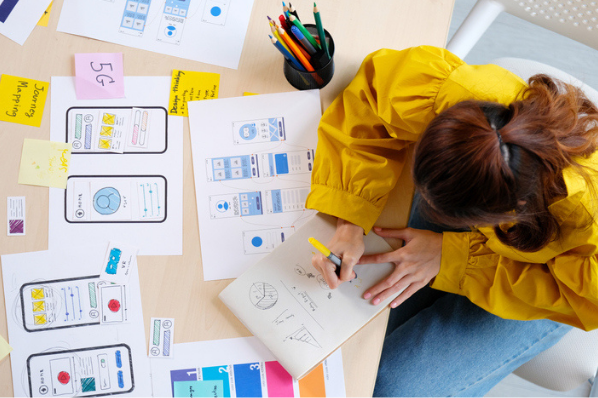The development of the Internet into the colossal informational apparatus that it is today can be traced back to the design trends that have changed the face of the World Wide Web over the years. Above all, the mobile revolution pushed designers to change their minds and today their job is to present an Internet that fits on the smallest screens without leaving out important information. But at a more specific level of design, you can also see how new trends are constantly emerging that will determine the Internet of the future. Below, we present 10 of these novelties so that the most modern web design does not catch you by surprise in 2020.
Trend 1: speed and performance even more important
More than a trend, it is a fundamental principle of well-designed pages : speed grows in importance. This is due in part to the mobile revolution because, after all, any web administrator wants their page to be easily accessible from mobile terminals. The faster pages load, the better experience users have. In addition, it can be seen today that web designers are dispensing with heavy elements to make their pages more agile, although this was already the case ten years ago.
Many other trends in web design start from here. Thus, the increasingly popular minimalism avoids the heaviest multimedia files in favor of less demanding storage formats. The success of long scrolling pages, which present the information on a single page that can be scrolled with the finger, is due to the fact that the user only has to load one page, and not several sub-pages. Along the same lines, the concept of white space, which is also increasing in popularity, implies the absence of superfluous elements that could slow down the page’s loading speed.
In its relatively short life, the Internet has seen its speed increase progressively, although there are voices who admit that it has not yet reached the speed it should have (mobile data networks are not powerful enough in many regions). But web designers can already remedy these shortcomings by simplifying the design of their projects.
Some of the most modern trends in web design, such as interactive animations, parallax scrolling or dynamic backgrounds, attract attention and improve, well applied, the assimilation of information, although they often have a negative impact on the performance of the web. For this reason, designers are forced to weigh which effects offer added value and which elements slow down the page for free. In general, the maximum aesthetic of “less is more” continues, without necessarily going back to flat design.
It should not be forgotten that the performance of a web page has a direct effect on the user experience. Here it is necessary to differentiate between the charging time as perceived and as it is in reality. Delays become problematic when the user perceives them as such. To avoid this, designers resort to the following measures:
Progress bars
If the user has to wait, then they should at least know how long. The progress bar doesn’t shorten the time the page loads, but if it’s designed in an attractive way it can make waiting less boring. The objective is to prevent the user from leaving the page when they are forced to wait for it to load. It is known that the margin of tolerance of the modern Internet user has been progressively decreasing as the connections improved.
Load the most important items first
Pages should be programmed in such a way that the above the fold content, which is displayed to the user at first glance without the need to scroll, is loaded first. If this content is shown to you, the user doesn’t care too much that the below the fold content is loaded later.
Progressive jpeg
The images that are integrated as progressive JPEG are not loaded from top to bottom like baseline images, but, using the so-called interlaced scan, the first thing that is shown to the user is a preview in lower quality that is detailed little by little until all the data of the complete image is loaded.
In short, the same thing that applies to texts, also applies to visual content: it must be unique, of high quality and relevant to the user. Also, it should be loaded only when the user opens it. Above all, users of mobile terminals or weak connections benefit the most from well-structured sites without superfluous data load.
WebAssembly (Wasm)
Web applications have become an essential element of the browsing experience. Although JavaScript improves the user experience because it allows them to interact with the website. Many applications may see a reduction in their performance. With WebAssembly (Wasm), a language was created not so long ago that, thanks to precompilation, it runs quickly in the browser. Although the standard is not yet as widespread, modern browsers support this technology.
Trend 2: CSS tricks
The CSS language is part of the routine in creating a web page. Thanks to cascading style sheets you can give web pages an attractive design. Since the CSS language is constantly developing, web designers continually have new possibilities to create attractive websites that adapt to their requirements. The latest advances focus on the flexibility of web pages, a fact particularly important when considering mobile devices. And it is that the images, along with the rest of the elements of a website, must be adapted to the different screens.
CSS Grid & CSS Flexbox
Since CSS3, the cascading style sheet language includes the Grid and Flexbox methods, which greatly facilitate the creation of designs that adapt to the screen size. With them, the distribution and scaling of elements is delegated to an intelligent system, without giving it full control: web designers can, for example, define maximum and minimum sizes.
SVG
Although the SVG image format is not new, it has increasingly attractive advantages: it guarantees a small file size, it can be flexibly scaled and it can be formatted with CSS, which makes it a web design trend in 2020. Given Since SVG is basically an XML file format, the source code (and therefore the graphic itself) can be directly modified with CSS. This combination allows web designers to embed graphics on the web page that adapt to the screen used or that even users can modify.
Trend 3: micro-interactions
Micro-interactions are a novelty in UX (user experience) design, with some user interactions on the page accompanied by small animation effects. It can be a “like” button that rewards the user with a movement or a vibration of the phone when they click on it.
Trend 4: long/infinite scrolling
The mobile-first paradigm does not only affect the size of the screens and the complete presentation of web content in different terminals but in the future, it will see its influence increase more and more in the content itself. One of the most significant novelties in this regard is the transition from click to scrolling, certainly no novelty, but which brings with it design concepts such as infinite scrolling or the parallax effect, which continue to garner supporters, so that it will also have to speak in 2020.
Infinite scrolling
Infinite scrolling allows the user to discover new content by scrolling across the page instead of clicking. When the end of a fragment is reached, the next one is loaded below. Blogs and social networks such as Facebook, Instagram, Reddit or Quora use this method to present the content to the user in a continuous informative thread. It will also play a role in the future.
The infinite scrolling is a suitable technique especially for pages with a very wide informative offer. While paging a blog with one hundred or two hundred posts isn’t a big deal, structuring a project with a constantly growing volume of text like that doesn’t make much sense – a user is unlikely to want to read page 812 specifically out of a total of 5782 subpages. The scrolling infinity is implemented with algorithms that filter the information prepared and presented offer the user the most relevant texts first.
But implementing it also means taking care of SEO aspects. Despite the fact that Google had its initial problems with the pages that applied it, today its use does not carry any risk thanks to the recommendations that the search engine itself offers to developers. In any case, don’t forget these four factors:
- An individual URL for each subpage
- Avoid overlapping content
- Items the user is looking for should be easily found
- Adequate charging time
Parallax effect
The parallax scrolling is not the latest trend in web design but will continue to be in vogue. The parallax effect has been used in the most modern pages for some years, providing a depth effect by making the different layers that make it move at different speeds. In the best implementations, this effect is accompanied by elements that motivate the user to take some action. This makes it such a good match with interactive storytelling.
Trend 5: personalized user experience
The presentation of content according to the target is integrated into the fundamental principles of modern web design. With an eye towards eCommerce, both the content you select and the way you present it visually should be tailored to the idiosyncrasies of your target audience. If you previously thought of abstract groups of people, in 2020 the individual user experience will catch the eye.
Nowadays the function “This could also like it” cannot be missing in any online store, but there are already providers such as Spotify or Netflix that go one step further designing the informative offer, the products and the forms of presentation according to the individual, so that hardly two users will see the same selection of individual content, even already on the home page.
A trend in web design in 2020 will be the personalized web page in which the user would obtain content that fits their habits. To determine the data on which to base the personalized user interface, web analysis tools such as Google Analytics or Matomo are used, which provide content providers with a very accurate image of how Internet users interact with web content.
Trend 6: WebXR
Most users already know virtual reality (VR) in the entertainment industry. Above all, the video game industry is betting on this technology, investing in the development of virtual reality glasses and the corresponding games. On the other hand, in the Smartphone sector, there are more and more applications with Augmented Reality (AR), a technology that merges the real environment with the digital information of the device. Now, the World Wide Web is also taking this step. With WebXR, W3C has created an interface that replaces current WebVR technology and allows browsers to display content with VR and AR.
With VR glasses it is possible to visit a website in three dimensions. As if it were a physical space, the user can navigate between the menu options and the content. For e-commerce, this technology has great appeal, as online stores, for example, can mimic the physical store experience. If you have the right glasses, you can test how WebXR works on the next Mozilla test page .
Trend 7: chatbots are here to stay
Programs that perform communication tasks are nothing new. The chatbots have emerged from the research field of artificial intelligence to integrate and today, on corporate websites or online stores. Generally, this is a small pop-up window that reads user queries and generates automatic responses that can be customized using machine learning algorithms. Thus, it is possible to give the user the impression that it is a flesh and blood employee who is offering support. They are usually implemented as assistants in the virtual sale or as an alternative to the classic FAQ (common questions).
The chatbots not tend to be intrusive, but normally activated by an interactive element to give the impression that it is an employee of the company has written. They usually have the possibility to respond to queries without leaving the website. Since the success of Siri, Alexa and Cortana, it seems that mistrust towards AI-based interlocutors has decreased somewhat. In spite of everything, even today they do not pass in the vast majority of the search function that, yes, reacts in a more dynamic way. We will have to be attentive to the evolution of chatbots in 2020.
Trend 8: clean and tidy interfaces
It’s easy to see from web design trends that it usually doesn’t take long before smart design finds copycats. The user interfaces of many pages and web apps are increasingly oriented in their design and composition of content to practices that have been proven effective. Here, usability always influences design.
It’s hard to go wrong with a neat and clear user interface. In the same way, you can also rest easy if you trust the consolidated portal format for pages with a lot of content or the typical design style of blogs for smaller pages. Despite everything, there are two recent trends in web design that we will also run into often in 2020.
Burger menu
This phenomenon has consolidated with such speed that for many Internet users this symbol is synonymous with menu. The small icon of three lines, also called menu icon burger (hamburger button), was used at the beginning dropdown menus for mobile sites and applications. Today it has already jumped to desktop versions, where it is often found as a menu icon. The symbol is reminiscent of the three levels of a hamburger and is often represented by the mathematical symbol ≡ (which means identical).
Card design
The second growing trend in user interface design is related to the visual presentation of content. The card layout, also called card-based layout, is increasingly used and consists of presenting texts, images or calls to the action on multiple boxes or cards that are spread over the entire surface of the interface. This form of composition offers many advantages and does not stop at the many possibilities offered by a clear and visually attractive design. The card layout is also advantageous from a much more pragmatic point of view and by acting as content containers, cards can move freely around the grid on the page. This way of distributing content works especially well in responsive design. This design format was made popular by web services like Pinterest or web design platforms like Dribbble.
Trend 9: dark mode
The mode dark not only is a trend in web design is applied mainly in the software sector. More and more users consider it important to use an alternative to screens with radiant light, especially annoying in dimly lit spaces. While in many programs and applications you can switch to dark screen mode, most websites still opt for white.
With CSS and JavaScript it is possible to offer this option to users. Each visitor can decide, depending on their preference, whether they want to apply dark or light mode on web pages. For this, the home page can have a button where it can be configured. While there is another more efficient option with the CSS “prefers-color-scheme” command, web pages react to browser settings. If the user has activated dark mode in Firefox, Safari, Chrome or Edge, the website is also automatically displayed in this way. This requires a second color scheme to be stored in the source code, an extra effort that is rewarded by greater user satisfaction.
Trend 10: Typography
We have been going for a good few years now. This next year will be no less and we will continue to see an explosion of typographic creativity. From brands that make their own fonts (and of course make them available to everyone) to impossible combinations. And if we can, in passing, we encourage them.
The trends in web design that ensure your success in 2020
The trends in web design for 2020 have usability in common. In the future, the pages are expected to be even more interactive and have a minimum loading time , designing the web content not according to the terminal, but optimized for a multi-device implementation according to responsive design.
With new techniques for web development, designers have new possibilities to increase the permanence time of users, without affecting the performance of the pages. For all these reasons, it is very important to keep in mind that, although trends change or new technologies emerge, users must always be kept at the center. That is why the web must always adapt to the target audience and the content offered.







